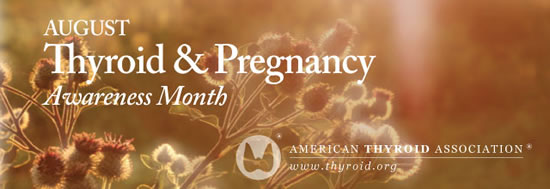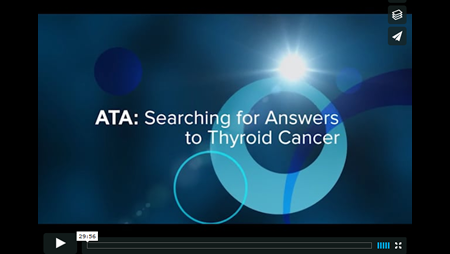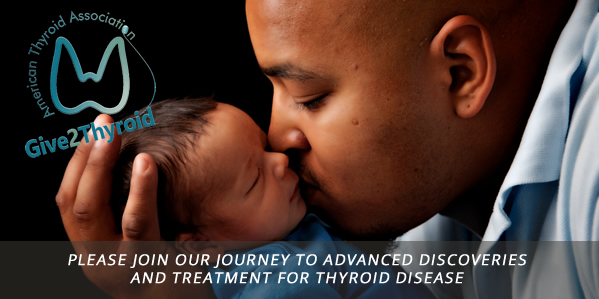Clinical Thyroidology for the Public summarizes selected research studies discussed in the previous month’s issue of Clinical Thyroidology, an official publication of the American Thyroid Association. Editor-in-chief, Alan Farwell, MD, FACE
Volume 11 Issue 8
Available in pdf format for saving and printing and Web page format for viewing online
PDF Format for Saving and Printing
Clinical Thyroidology for the Public Volume 11 Issue 8 (PDF file, 5.72 MB)
TABLE OF CONTENTS – Web Format
HYPERTHYROIDISM Hyperthyroidism in infants of mothers with Graves’ disease
Graves’ disease caused by antibodies that attack the thyroid and turn it on. If these antibodies are passed to the baby during pregnancy, the baby may develop neonatal Graves’ disease. Symptoms typically develop within the first 2 weeks of life. This study was done to look at the risk factors in the newborn that may help predict the likelihood of developing neonatal Graves’ disease prior to the onset of symptoms.
Banigé M et al 2018 Research Group for Perinatal Dysthyroidism (RGPD) Study Group 2018 Prediction of neonatal hyperthyroidism. J Pediatr Epub 2018 Mar 28. PMID: 29605392.
(PDF File for saving and printing, 806 KB)
HYPOTHYROIDISM First-trimester maternal thyroid function is not associated with child scores on standardized educational tests
Thyroid hormone is necessary for development and growth of brain in developing babies during pregnancy. Studies have shown that hypothyroidism and low thyroid hormone levels without hypothyroidism may be associated with some developmental problems in children. This present study was aimed to assess any potential relationship between the results of standardized educational assessment tests of children and the thyroid function status of their mother at the time of pregnancy.
Nelson SM et al 2018 Maternal thyroid function and child educational attainment: prospective cohort study. British Medical Journal; 360:k452. PMID: 29463525.
(PDF File for saving and printing, 616 KB)
THYROID BLOOD TESTS Thyroid function tends to remain stable in those without risk factors for hypothyroidism or hyperthyroidism
If a person has certain risk factors, the chance of developing hypothyroidism or hyperthyroidism is higher than in the general population. One such risk factor is having high blood levels of TPO antibodies. This study was performed to see how stable TSH blood tests are in adults with few risk factors for hypothyroidism or hyperthyroidism.
Rosario PW and Calsolari MR. 2018 Serum TSH level stability after 5 years in euthyroid adults at low risk for thyroid dysfunction. Arch Endocrinol Metab. May 17. pii: S2359- 39972018005002003. doi: 10.20945/2359-3997000000037.
(PDF File for saving and printing, 651 KB)
THYROID CANCER Noninvasive follicular thyroid neoplasms with papillary-like nuclear features (NIFTP) are similar to benign tumors
The term noninvasive follicular thyroid neoplasm with papillarylike nuclear features (NIFTP) was introduced two years ago to describe select slow growing forms of papillary thyroid cancer that do not seem to grow or spread, and consequently may be able to be treated like benign thyroid nodules. The purpose of the following study was to characterize the genetic make-up and clinical behavior of NIFTP tumors and to compare them to both benign tumors and more invasive forms of papillary thyroid cancer.
Johnson DN et al 2018 Noninvasive follicular thyroid neoplasms with papillary-like nuclear features (NIFTPS) are genetically and biologically similar to adenomatous nodules and distinct from papillary thyroid carcinomas with extensive follicular growth. Arch Pathol Lab Med. Epub 2018 Mar 27. PMID: 29582677.
(PDF File for saving and printing, 618 KB)
THYROID CANCER More diagnostic criteria are needed to define noninvasive follicular thyroid neoplasm with papillary-like nuclear features (NIFTP)
The term NIFTP was introduced two years ago to describe select slow growing forms of papillary thyroid cancer that do not seem to grow or spread, and consequently may be able to be treated like benign thyroid nodules. The goal of this study was to characterize the incidence of NIFTP at a large tertiary care endocrine surgery center and determine the cancerous potential of NIFTP
Parente DN et al 2018 Clinical safety of renaming encapsulated follicular variant of papillary thyroid carcinoma: is NIFTP truly benign? World J Surg 42:321–326.
(PDF File for saving and printing, 737 KB)
THYROID CANCER Is active surveillance reasonable for low-risk papillary thyroid microcarcinomas?
While surgery is usually recommended for patients with thyroid cancer, it is becoming clear that active surveillance could be considered for some patients with low risk small papillary thyroid cancers. Accumulating evidence over years has revealed that there is a low rate of cancer progression during active surveillance, and surgery performed later when progression is noted is safe. The goal of this study was to evaluate the physician acceptance and implementation patterns of active surveillance at Kuma Hospital, as a model that could be used for other institutions around the world.
Ito Y et al 2018 Trends in the implementation of active surveillance for low-risk papillary thyroid microcarcinomas at Kuma Hospital: gradual increase and heterogeneity in the acceptance of this new management option. Thyroid 28:488–495. Epub 2018 Apr 2. PMID: 29608416.
(PDF File for saving and printing, 657 KB)









